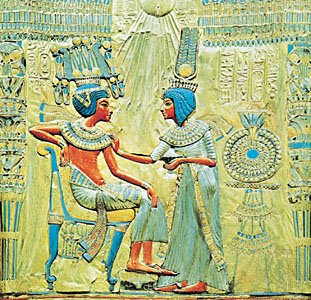Tutankhamen
 King Tutankhamen and Queen Ankhesenamen, detail from the back of the throne of Tutankhamen; in the Egyptian Museum, Cairo.
King Tutankhamen and Queen Ankhesenamen, detail from the back of the throne of Tutankhamen; in the Egyptian Museum, Cairo. Flourished 14th century BC
also spelled Tutankhamun original name Tutankhaten king of Egypt (reigned 1333–23 BC), known chiefly for his intact tomb discovered in 1922. During his reign, powerful advisers restored the traditional Egyptian religion and art, both of which had been set aside by his predecessor Akhenaton, who had led the “Amarna revolution.”
Medical analysis of his mummy shows that Tutankhaten was probably a brother of Smenkhkare, his immediate predecessor, and son-in-law of King Akhenaton, with whom Smenkhkare was coregent. As suggested by a docket from Tell el-Amarna (Akhenaton's capital Akhetaton) and other circumstantial evidence, young Tutankhaten probably became king after the deaths of Akhenaton and Smenkhkare. Seals from Tell el-Amarna suggest that Tutankhaten resided there during his first year or two as king. He was married to Ankhesenamen, Akhenaton's third daughter, probably the eldest surviving princess of the royal family, to solidify his claim to the throne. Because at his accession he was still young, his vizier and regent, Ay, who had ties with the royal family, and the general of the armies, Horemheb, became his chief advisers.
Under their tutelage, Tutankhaten moved his residence to Memphis, the administrative capital, near modern Cairo, and restored his father's Theban palace. He also changed his name to Tutankhamen—at the latest by the fourth year of his reign—and issued a decree restoring the temples, images, personnel, and privileges of the old gods and also admitting the errors of Akhenaton's course. In spite of these capitulations to the Amon priesthood, no proscription or persecution of the Aton, Akhenaton's god, was undertaken. Royal vineyards (up to the king's death) and elements of the army still remained named after the Aton.
During the ninth year of Tutankhamen's reign, perhaps under Horemheb, the Egyptians marched into Syria to assist Egypt's old ally, the Mitannian kingdom of northern Syria, which was embroiled in hostilities with vassals of the Hittites. As reinforcements sent by the Hittite king hastened to aid his vassals, Tutankhamen unexpectedly died, aged about 18 years. Because none of his children survived, Ay succeeded him, perhaps marrying his widow.
 Tutankhamen, gold funerary mask found in the king's tomb, 14th century BC; in the Egyptian Museum, Cairo.
Tutankhamen, gold funerary mask found in the king's tomb, 14th century BC; in the Egyptian Museum, Cairo.
0 comments:
Post a Comment